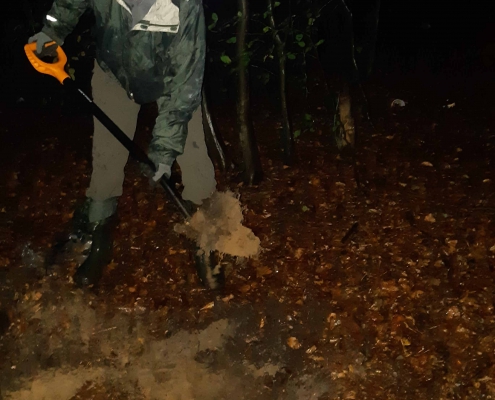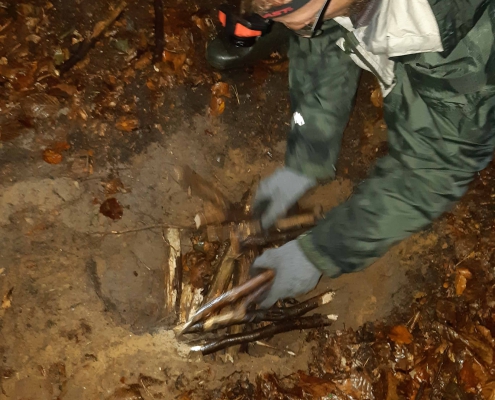We moved the anthill of the red wood ant Formica polyctena
OPEC heat main in Gdynia
The relocation of the anthills as part of o environmental compensation, was related to the planned modernization of the heat main in Gdynia. The facility is managed by OPEC, a company that operates in the field of, among others, generation, transmission, distribution and circulation of heat. OPEC was also our direct contractor.
Anthills located on the supports of the main
The situation was quite unusual this time due to the location of the anthills. Four anthills were located within the supports of the heat main. The relocation of the anthills took place in the early morning hours and started before sunrise. Fortunately, the aura turned out to be kind. The overnight rainfall stopped at dawn, allowing the work to be carried out efficiently.
Selection and preparation of the site for translocation of the anthill
Moving the anthill is preceded by selecting replacement sites that meet the ecological requirements of a given ant species. Red wood ants prefer sunny places at forest edges, although more shaded positions are also found. In the place intended for a new anthill, an appropriate-sized hole should be dug, depending on the size of the anthill. A rotten branch needs to be placed at its bottom and covered with small twigs, thus creating a structure resembling a roof.
Moving the queen
The translocation of the anthill takes place in two stages. First, the top layer of the substrate is taken together with the ants. Then, we collect the inner part of the nest with the adults and, most importantly, their eggs into a separate container or bag. It is crucial that the translocation also includes the queen. It is obviously impossible to find the queen while taking the substrate. Nevertheless, taking at least 3/4 of the entire nest increases the likelihood that the queen will also be moved.
Red wood ant Formica polyctena – species protection
The red wood ant, as well as other related species of domestic ants, are under partial species protection in Poland. Due to the conservation status of this species, it is prohibited by law to keep and transport the red wood ant, not to mention killing it. For the above reasons, before commencing the translocation of anthills, it was necessary to obtain a derogation from the Regional Directorate for Environmental Protection in Gdańsk, allowing for derogations from the above-mentioned prohibitions.
Ants are protected because they are useful
Protection of the ants is not accidental. They perform a number of important ecological functions. They loosen and aerate the soil, making it easier for water and oxygen to reach the plant roots. Ants are effective gardeners because they actively search for seeds and transfer them to their anthills, causing them to spread randomly. They also process enormous masses of organic matter and are nutritious for many other organisms and animals.





